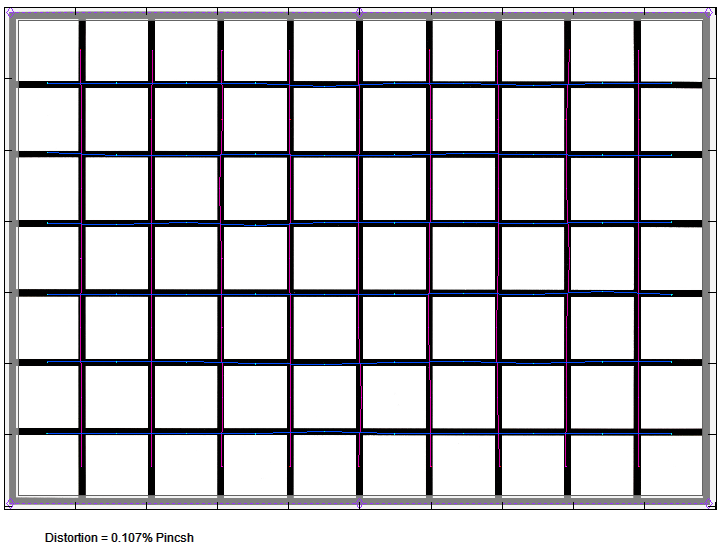|
Sigma 85mm f/1.4 HSM DG ART ( Canon ) - Review / Test - Analysis |
|
Lens Reviews -
Canon EOS (Full Format)
|
|
Page 2 of 3

Distortion
The Sigma 85mm f/1.4 HSM DG Art produces images that are essentially free of distortions (0.1%).

Vignetting
The vignetting characteristic is rather typical for such a lens. Thus there’s some substantial light falloff at fully open aperture (1.8EV). Stopping down to f/2 reduces the issue drastically and the vignetting is pretty much gone from f/2.8 onward.

MTF (resolution) on the EOS 5Ds R (at 50 megapixels)
The EOS 5Ds R is usually a tough test bed for most lenses but the Sigma 85mm f/1.4 HSM DG Art is actually capable of exploiting most of the potential of the 50mp sensor. The center quality is very good at f/1.4 but even the outer image regions is sharp here - which is nothing short of amazing at this setting. Stopping down to f/2 increases the quality slightly. The peak performance is reached between f/4 and f/5.6. The center quality is superb here and the borders/corners are scratching the excellent mark here - a first to date. Diffraction is limiting the quality from f/8 onward but f/11 remains easily usable.
The centering quality of the tested lens was good. The field curvature is low.
Please note that the MTF results are not directly comparable across the different systems!
Below is a simplified summary of the formal findings. The chart shows line widths per picture height (LW/PH) which can be taken as a measure for sharpness.
If you want to know more about the MTF50 figures you may check out the corresponding Imatest Explanations

MTF (resolution) on the EOS 5D II (at 21 megapixels)
Many users are still using Canon DSLRs with 20/21mp sensors so let’s have a look here. Now it’s not really coming as a surprise but the quality is breathtaking in this scope. The image quality is pretty much excellent from f/1.4 all the way down to f/8.
Please note that the MTF results are not directly comparable across the different systems!
Below is a simplified summary of the formal findings. The chart shows line widths per picture height (LW/PH) which can be taken as a measure for sharpness.
If you want to know more about the MTF50 figures you may check out the corresponding Imatest Explanations

Chromatic Aberrations (CAs)
The outstanding resolution is accompanied by a very low CAs (chromatic aberrations) with an average pixel width of just 0.5px at the image borders at f/1.4 and essentially none beyond f/2.8.

Bokeh
Enough of the superb sharpness … let’s check the softness part thus the rendering of the out-of-focus blur aka bokeh. After all the Sigma is primarily designed for shallow depth-of-field photography. It does a very good job here albeit it’s not perfect.
Let’s have a look at the general blur characteristic first. The important background (left crop below) is smoothly rendered with creamy contrast transitions. However, the less critical image foreground (right crop) is a bit nervous in comparison.
 Out of focus highlights are nicely rendered. The inner discs are very even and the discs show no outlining. Stopping down has no negative effects til f/2.8.
Out of focus highlights are nicely rendered. The inner discs are very even and the discs show no outlining. Stopping down has no negative effects til f/2.8.
 That being said, the discs deteriorate towards the image corners (cat’s eyes) as shown below. This is a vignetting effect and as unfortunate as it may be it affects all full format lenses (when used on full format cameras).
That being said, the discs deteriorate towards the image corners (cat’s eyes) as shown below. This is a vignetting effect and as unfortunate as it may be it affects all full format lenses (when used on full format cameras).

Bokeh Fringing
In a perfect world scenario, you won’t see any axial CAs thus color fringing on the Z-axis. However, just like most (all?) of the other fast 85mm lenses, the Sigma 85mm f/1.4 HSM DG Art reaches its limits here. If you observe the image crops below, you should be able to spot greenish halos beyond the focus point and purple halos in front of it. This effect is very pronounced at f/1.4. Stopping down reduce the color fringing but it remains visible till at least f/4.
If you scroll through the aperture range you may also spot that the focus point shifts towards the rear. These are a so-called residual spherical aberrations (RSA). Your camera determines the focus point at f/1.4 even if you select -say- f/4 for your image. Thus RSAs can result in focus accuracy issue specifically in a close focus scenario. It’s a lesser issue at longer focus distances because the depth-of-field is hiding the effect in this case.
|
Move the mouse cursor over the f-stop marks below to observe the respective LoCAs
|
| f/1.4 |
f/2 |
f/2.8 |
f/4 |
f/5.6 |
|

|
|